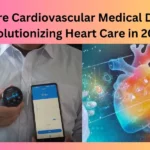Welcome to the future of heart care! In 2024, the landscape of cardiovascular health is evolving at a rapid pace, thanks to groundbreaking advancements in medical technology. Cardiovascular medical devices are not just changing the game; they’re revolutionizing the way we approach heart care. In this article, we’ll dive deep into the innovative world of cardiovascular medical devices and explore how they’re reshaping the future of healthcare.
1. The Rise of Cardiovascular Medical Devices
The past decade has witnessed an unprecedented surge in the development and adoption of cardiovascular medical devices. From pacemakers to stents, these devices are designed to diagnose, monitor, and treat various heart conditions with greater precision and effectiveness than ever before.
1.1 Pacemakers: A Lifesaving Innovation
Pacemakers have long been a cornerstone of cardiovascular care, but in 2024, they’re more advanced than ever. These small, implantable devices deliver electrical impulses to regulate the heart’s rhythm, ensuring that it beats at a steady pace. With improved battery life and enhanced functionality, modern pacemakers are prolonging and enhancing the lives of millions of patients worldwide.
1.2 Stents: Opening New Pathways
Stents are another crucial tool in the cardiologist’s arsenal, used to treat blockages in the arteries and restore blood flow to the heart. In recent years, the development of drug-eluting stents has significantly reduced the risk of restenosis, offering patients a more durable solution for coronary artery disease.
2. Advancements in Imaging Technology
In addition to therapeutic devices, imaging technology plays a pivotal role in cardiovascular medicine. Innovations in this field have enabled healthcare professionals to visualize the heart and its surrounding structures with unparalleled clarity, facilitating more accurate diagnoses and treatment planning.
2.1 3D Printing: A New Dimension in Imaging
One of the most exciting developments in cardiovascular imaging is the advent of 3D printing technology. By converting medical imaging data into physical models, 3D printing allows surgeons to better understand complex cardiac anatomy and plan intricate procedures with greater precision.
2.2 Artificial Intelligence: Enhancing Diagnostic Accuracy
Artificial intelligence (AI) algorithms are revolutionizing the interpretation of medical imaging studies, enabling rapid and accurate diagnosis of cardiovascular conditions. By analyzing vast amounts of data, AI-powered imaging systems can detect subtle abnormalities that might go unnoticed by human observers, leading to earlier intervention and better outcomes for patients.
3. Remote Monitoring and Telemedicine
The rise of telemedicine has transformed the way patients interact with healthcare providers, and cardiovascular medicine is no exception. Remote monitoring devices allow individuals with heart conditions to track vital signs and share data with their physicians from the comfort of home, facilitating proactive management of their health.
3.1 Wearable Technology: Keeping Hearts in Check
Wearable devices such as smartwatches and fitness trackers are empowering individuals to take charge of their cardiovascular health by monitoring key metrics like heart rate, activity levels, and sleep patterns. These devices provide valuable insights that can help identify potential issues early on and guide lifestyle modifications to improve heart health.
3.2 Virtual Consultations: Breaking Down Barriers
Virtual consultations have emerged as a convenient and efficient way for patients to access specialized care without the need for in-person visits. Whether it’s a routine follow-up or a consultation with a distant specialist, telemedicine platforms make it easier than ever to connect with healthcare professionals and receive timely guidance on managing cardiovascular conditions.
Conclusion:
In conclusion, the field of cardiovascular medicine is undergoing a remarkable transformation driven by technological innovation. From advanced medical devices to cutting-edge imaging technology and remote monitoring solutions, the future of heart care has never looked brighter. By harnessing the power of these advancements, we can improve outcomes, enhance patient experiences, and ultimately, save lives.
FAQs:
1. Are cardiovascular medical devices safe?
Yes, cardiovascular medical devices undergo rigorous testing and regulatory scrutiny to ensure safety and efficacy before they are approved for clinical use.
2. How do I know if I need a pacemaker or a stent?
Your cardiologist will evaluate your medical history, symptoms, and diagnostic test results to determine the most appropriate treatment option for your specific condition.
3. Can I use wearable technology to monitor my heart health?
Yes, many wearable devices offer features for tracking heart rate, activity levels, and other relevant metrics to help you stay informed about your cardiovascular health.
4. Are virtual consultations as effective as in-person visits?
Virtual consultations have been shown to be comparable to in-person visits for many cardiovascular conditions, offering convenience and accessibility without compromising quality of care.
5. What role does lifestyle play in heart health?
Lifestyle factors such as diet, exercise, smoking, and stress management play a significant role in cardiovascular health and can influence the risk of developing heart disease.















